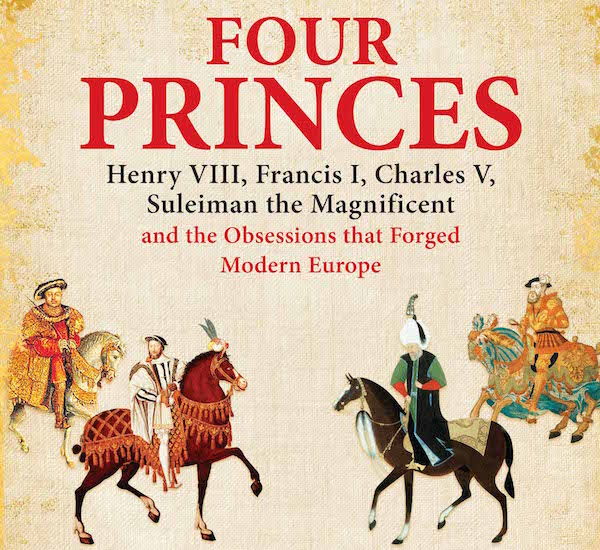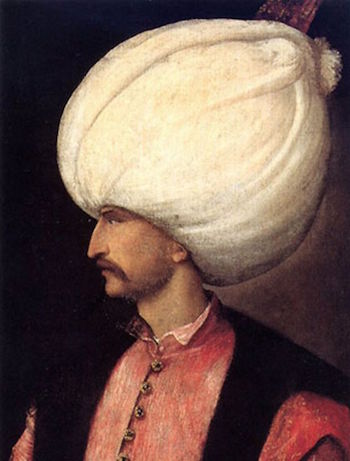Book Review: “Four Princes” — Sixteenth Century Carnage
A historian’s view of the tumultuous world of early sixteenth century Europe, an age of exploration, revolt, and religious upheaval.
Four Princes: Henry VIII, Francis I, Charles V, Suleiman the Magnificent
and The Obsessions that Forged Modern Europe by John Julius Norwich. Atlantic Monthly Press, 304 pp. $26.00.

By Thomas Filbin
At eighty-seven years of age John Julius Norwich has already authored epic works of history on Venice and Byzantium, written and produced numerous television programs, and now adds another star to his constellation by offering a view of the tumultuous world of early sixteenth century Europe, an age of exploration, revolt, and religious upheaval.
Born the son of the celebrity couple Duff and Diana Cooper, he assumed the name Norwich on succeeding his father as Viscount Norwich. After an early career as a diplomat like his father he became a writer full time. His style of history is neither pedantic nor simplistically popular, but thoughtful with the fluidity of the able storyteller.
The four princes in question possessed different personalities, but similar world views: i.e., a belief in the inherent superiority of their own realms and the need and right to be supreme. Occasionally they formed alliances, while at other times they fought wars with one another depending on the exigencies of the moment. The obsessions of the book’s title included control of the western shores of Europe and the Atlantic explorations, the matter of religion, and the anxieties of having similarly powerful nations with the same goals in such proximity.
Henry VIII, born a younger son and thrust onto the throne when his brother Arthur died, was a man of enormous appetites and insecurities. Everyone knows the story of “the king’s great matter,” his petition to the pope to have his marriage to his brother’s widow, Catherine of Aragon, annulled. The split of the English church from Rome ensued, and Henry’s quest for heirs and happiness led him to five more marriages. On the political front, he feared France and undertook two failed invasions to reassert English claims to fiefdoms dating from Norman times. His relations with Charles V suffered because Henry’s deposed wife Catherine was the emperor’s aunt. “Don’t piss off the in-laws” should have been one of the golden rules in the handbook for kings, especially when they govern large swaths of the civilized world.

Veteran historian John Julius Norwich. His style of history is neither pedantic nor simplistically popular, but thoughtful with the fluidity of the able storyteller.
Oddly enough, despite being a Renaissance man who could play music, dance, and compose poems, as well as read Latin and debate theology, Henry missed the chance to explore the lands beyond the sea and acquire wealth and empire as the Spanish, Portuguese, Dutch, and French did. Perhaps it was island mentality, the belief that all one needed was within the mileage of your ‘hood, but it was as big a case of missing the boat as there could be. “Had he lavished on South America half the attention he paid to his grotesquely outdated ambitions in France,” Norwich notes,” it is quite possible that parts of that continent might be speaking English today.
Francis I was a true Renaissance prince, even more intellectual than Henry, with a great affection for the arts. He patronized Da Vinci and went full throttle on building Chambord, as well as continuing work on the chateaux of d’Amboise and Blois. France was a mighty nation militarily, but since Spain was part of the Hapsburg empire, Francis feared being in the position of being surrounded by a greater power, with Spain on one side and Germany on the other. He sought an alliance with Henry at the famous meeting of the Field of the Cloth of Gold in 1520, but very little came of it despite their huge entourages, plenty of glitz and glitter, and medieval jousting.
Francis’ second wife was the sister of Charles V, so once again marital relationships complicated relations between the states. “Appalled by the vast new wealth that was flooding from the New World to the coffers of his brother-in-law and rival Charles V, Francis was determined that Charles should not have it all his own way…” and so Francis sent expeditions under Verrazzano to Newfoundland and Manhattan, and Cartier to the Saint Lawrence, baby steps perhaps, but which over the next two centuries would expand to much of North America from Canada and the Great Lakes to the Gulf of Mexico. When Francis could make no headway with European alliances, he sought out the Ottomans, much to the horror of Christian states.

Suleiman the Magnificent
Suleiman the Magnificent ruled for 46 years and expanded his empire substantially into eastern Europe. A man of culture who wrote poetry in Turkish and Persian, he undertook legal and administrative reform, encouraged the arts, employed engineers and architects to build palaces, mosques, roads, and bridges, and sent Turkish ships to sail much of the known world in either commerce or conquest. As Norwich notes, “Of all the celebrated men of history, only two are known as ‘the Magnificent’. One is Lorenzo de’ Medici, the other is Sultan Suleiman.” His relations with Europeans were shaped by competing desires: a interest in military conquest tempered by a preference for stability and not biting off more than he could chew.
Charles V was perhaps the most complicated of the four and. in the end, is something of an enigma. A religiously devout workhorse who involved himself in everything affecting his vast domains, he longed eventually to put it all aside and retreat to a monastery.
The Holy Roman Empire, as we all learned in school, was neither holy, nor Roman, nor an empire, but as a joinder of much of middle Europe with Spain, it was as close to a superstate as any since the time of Charlemagne. Charles’ reign was characterized by a number of wars, both with his European fellows and with the Turks. When the Reformation broke out, he attempted to enforce Catholicism, but the princes who supported Luther resisted, and the Peace of Augsburg in 1555 divided the empire into Catholic and Protestant regions. Exhausted by conflicts and the demands of leadership, he abdicated in 1556 in favor of his younger brother Ferdinand. He failed in his attempts to keep Christianity unified in Roman orthodoxy, “…and to see the Church he loved split down the middle, first by Martin Luther and his followers, and later by Henry VIII, caused him bitter sorrow.”
When he left the throne, it was not to a threadbare monk’s cell, however, but to comfortable digs in a house near a monastery in sunny Spain with a view of the garden and a modest staff of 150 composed of barbers, cooks, valets, musicians, and even brewers. Once a king, always a king, apparently.
The world of these monarchs was turbulent and re-ordered Europe for the next several centuries. It is hard for us today to imagine so much power situated in so few hands, and that the wishes and whims of kings could make war or peace as simply as we would order breakfast. Norwich paints these royals in all their colors: greed, lust, pride, ambition, and of course, arrogance, for what would be the fun of being a king without the ability to rub someone else’s nose in it?
Thomas Filbin has reviewed books for The New York Times Book Review, The Boston Globe, and The Hudson Review.
